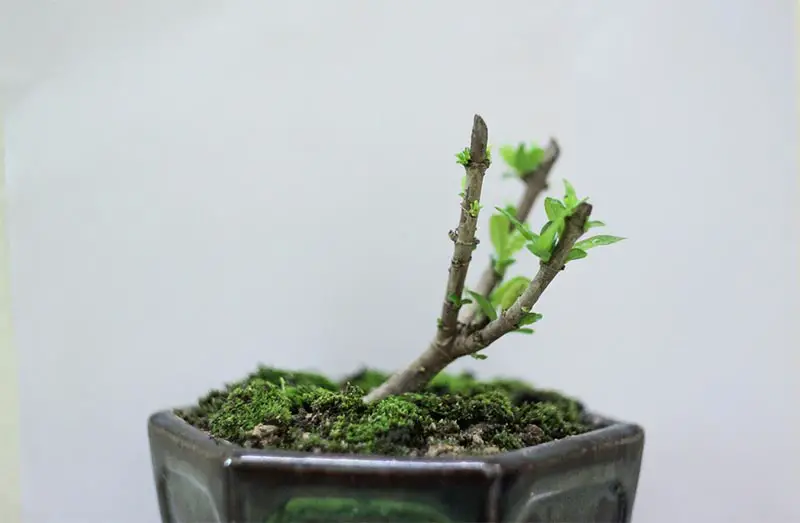How to Repot a Bonsai
Repotting your bonsai is critical to ensure that your tree stays healthy and thriving. All bonsai trees need to be repotted every few years. This is an essential step in keeping bonsai, and the art of repotting is very rewarding to bonsai enthusiasts.
While your tree grows in your chosen bonsai container, the root system expands and takes nutrients from within the soil to sustain the tree. If you never repot the tree, the roots will grow so dense that the bonsai will become pot bound. When this happens, your tree will suffocate as the roots cannot take up enough oxygen leading to death. Also, as the tree grows, it depletes the nutrients from within the soil, and if the ground isn’t replaced, the bonsai will also die.
For many first-time bonsai growers, the thought of repotting a bonsai can be intimidating. Any time you have to bother the roots of your tree, there’s an amount of risk to the tree’s health. However, if you do it correctly following the guidelines we provide, there’s no reason why your tree should suffer. In the end, it will be much happier with fresh soil and more space to grow.

Tips to Keep in Mind Before You Repot a Bonsai
Before you get everything ready and want to start repotting your precious bonsai, just hold on first. There are a few things that every bonsai enthusiast should know before repotting their precious miniature tree. Let’s go over a few tips to keep in mind before you repot your bonsai.
When Should You Replant Your Bonsai?
Knowing when to replant your bonsai is crucial as it can affect the health and growth of your tree. As such, you want to make sure that you do any repotting when there would be the least amount of stress on the tree. For most trees, this would be in late winter or early spring before your tree starts budding. However, I recommend that you check the requirements of your species to ensure that you repot at the right time.
Also, trees need to be repotted every few years to ensure that the soil is replaced with new nutrient-rich soil. For most species, this would be every three to five years. However, this can vary from species to species as some are more vigorous feeders and may deplete the soil of nutrients much quicker. Make sure to refer to a care guide for your species to ensure you know how long your tree can go in the same pot.
We have a detailed bonsai tree care guide with all the relevant information. Check the guide out here!

There are times when an ’emergency’ repotting is necessary. For example, if you’ve just brought a tree home from the nursery and it’s suffering in the pot, or your tree has become pot bound. In cases like these, you might need to do a repotting that’s not ideal at that time of year. If this is the case, make sure to do a very quick repotting and not disturb the root ball too much.
Do You Have to Prune the Roots Every Time You Repot Your Bonsai?
You might not need to prune back the roots if you repot your bonsai into a bigger container. However, if you’re staying with the same size container or even going a bit smaller, you may need to prune the roots back to fit nicely into the container with enough room to grow.
Do You Need to Repot Your Bonsai Into a Bigger Container?
Once you’re happy with the thickness of your bonsai’s trunk, there’s no need to repot it into a bigger container when you do the repotting. After all, the art of bonsai is keeping miniature trees in containers. You don’t necessarily want your tree to grow too big.
If you keep the tree in the same size container, you’ll do the repotting to provide new nutrient-rich soil and trim back the roots to ensure they have more space to grow.
Do You Need Premium Bonsai Soil When Repotting Your Bonsai?
It’s recommended that you use good quality bonsai soil for your trees. This is especially true if you’re just starting in the art of bonsai. However, many bonsai enthusiasts start mixing their own soil as their collections grow to adjust to their specific location, needs and the species they own.
When choosing bonsai soil, it’s often recommended to choose a blend of akadama, pumice and lava rock in a ratio of 2:1:1. Conifers and pines may prefer a 1:1:1 ratio instead.
What Tools Do You Need to Repot Your Bonsai?
There are a few things that you will need when you repot your bonsai. Make sure you have them all within reach when you start the process so that you don’t leave the roots exposed while you look for your tools.
Here are a few tools that can be used during repotting:
- Root rake
- Pruning scissors
- Chopstick
- Wire Cutters (Optional – if your tree has been wired into the pot or will be wired into the pot)
- Wire (Optional – if you will be wiring the tree into the pot)

Steps to Repot Your Bonsai
Now that we have some of the other considerations out of the way, let’s get to the steps you need to take to repot your bonsai. For the repotting, get ready to get down and dirty – literally.
Step 1: Get Your Bonsai Out of Its Pot
The first step is to remove the bonsai tree from the container. If you used wires to secure the tree to the pot, you would need to cut those wires first before removing the tree from the pot. You can give your tree a little jiggle to loosen it up a bit. Then push from underneath through the drainage holes to lift the bonsai from the pot.
If the drainage holes are too small to let you do this, you can grab the bonsai gently by the base of the trunk and slowly pull the tree out of the container.
Step 2: Evaluate the Roots to See How Much Pruning Is Necessary
Once you’ve removed the tree from the container, you’ll need to evaluate how much work needs to be done. If the whole tree and soil came out of the container as a unit and you can visibly see roots circling inside the pot, that’s a sign the repotting and a bit of pruning are necessary.
Step 3: Start to Remove the Soil from the Roots
Place your bonsai on the workbench in front of you. Then, using a chopstick, start teasing the soil loose. Start on the sides, and then move to the bottom. You’ll need to work gently so that you don’t damage the roots in the process. Make sure to keep the roots moist while you work.
Pro Tip: If you’re repotting a pine, don’t remove all the soil as the tree needs some of the original soil and mycorrhizal fungus to survive.
Step 4: Comb Out the Roots
Once you’ve removed most of the soil from the roots, you can use your root rake to comb out the roots in a radial pattern gently. The roots should fan out evenly from all sides. This step is vital to help develop a balanced nebari (root base/ root flare) for your tree.
Step 5: Prune the Roots
With your roots combed out, you can trim any roots that are notably longer than the rest. You can also prune the roots back a bit so that they will fit nicely into the container. When pruning roots, never remove more than ⅓ of the root system. Cover the roots with a damp cloth in a shady space until you are ready to place the bonsai in the new pot.
Step 6: Get the Container Ready
To get the container ready, place mesh over the drainage holes and secure it in place with some wire.
You’ll also need to add another long piece of wire through the drainage holes with the points towards the top of the tree. This wire will be used to secure the tree to the pot. This is an important step because, after the repotting and root pruning, the tree will not be established correctly in the soil yet and will start to grow new roots.
A sudden gust of wind or similar could be enough to loosen the tree or even pull it from the pot. This could damage the fragile developing roots and even kill your tree.
When the wire and mesh have been included, you can add some of the bonsai soil in a mound in the center of your pot.
Step 7: Place the Bonsai in the Pot
Once your pot has been adequately prepared, you can place your tree in the desired location on top of the mound of soil. Take your time with this step as you look for the position that best shows off your tree.
Choose the front of your tree and make sure it’s aligned with the front of your pot. Once you are happy with the placement, use the wires to secure the tree to the position.
Step 8: Add More Soil and Water
Now fill up the container with bonsai soil. Make sure to cover all the roots and use the chopstick to work the ground between and underneath the roots. Once you’ve filled the pot and any gaps, you can give your tree a good watering. Make sure that you water enough so that all the soil is wet and there is water running out of the drainage holes.

Final Thoughts
Repotting is an essential step in the art of bonsai, and it can also be one of the scariest to attempt. Repotting your bonsai will ensure that the tree stays healthy and thriving, with enough nutrients and space in the pot for the roots to develop.
The most crucial part of repotting is making sure that you do it at the right time for your tree, and when you do it, you work carefully and gently with the roots and remove only what you need to.







